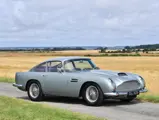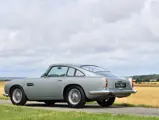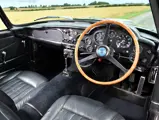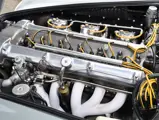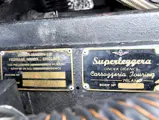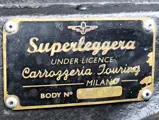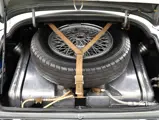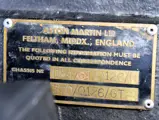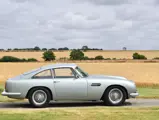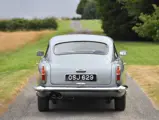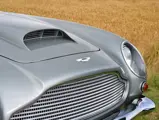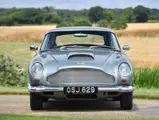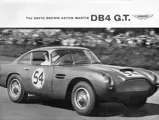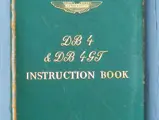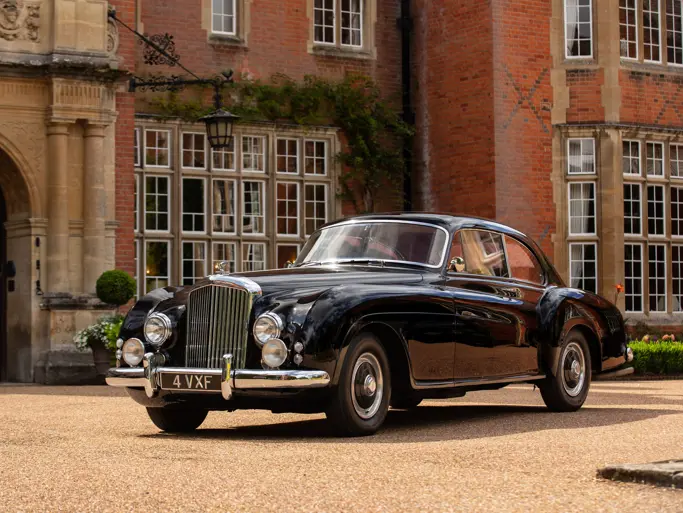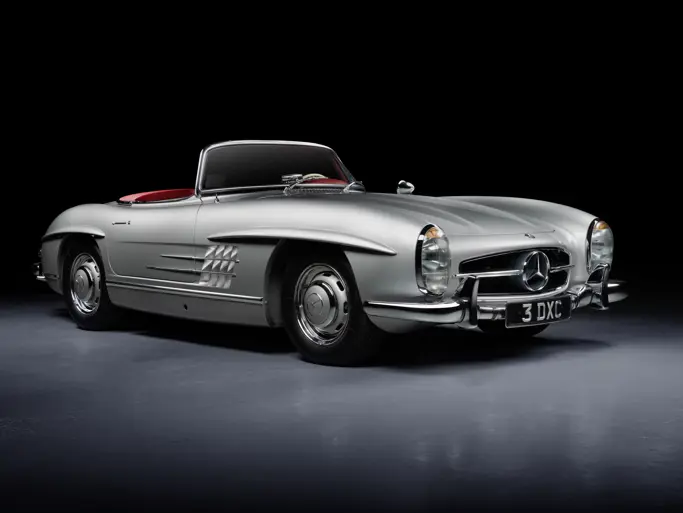London 2016
1960 Aston Martin DB4GT
{{lr.item.text}}
£2,408,000 GBP | Sold
 | London, United Kingdom
| London, United Kingdom
{{internetCurrentBid}}
{{internetTimeLeft}}

- The original “Gentleman’s racer”
- Conceived for competition with full comfort appointments
- One of only 75 factory-bodied examples built
- Original, matching-numbers engine
- Original alloy panels, without evidence of damage
- Maintained to a high standard
- Known ownership from new; extensive history file
302 bhp, 3,670 cc DOHC inline six-cylinder engine with triple dual-throat Weber 45 DCOE carburettors, four-speed manual transmission, independent front suspension with upper and lower control arms, coil springs, and an anti-roll bar; live rear axle with Watt’s linkage, trailing links, and coil springs; and four-wheel hydraulic disc brakes. Wheelbase: 2,360 mm
The stars aligned for David Brown and Aston Martin upon the introduction of the all-new DB4 model in late 1958. A competition-oriented variant, the DB4GT, was formally introduced in September 1959 at the London Motor Show, based on the race-winning prototype DP199/1. This was the year in which Aston Martin achieved outright victory at Le Mans (1st and 2nd overall, with Carroll Shelby and Roy Salvadori at the front, followed by Maurice Trintignant and Paul Frere), and took the World Sportscar Championship title, the smallest manufacturer ever to do so, before or since. The GT prototype won its first outing at Silverstone in May 1959, on Bank Holiday weekend, in the hands of Stirling Moss, and was one of the first cars away at Le Mans that June, in the same light green livery as the victorious Aston Martin DBR1s.
The GT was developed for increased performance by making it shorter, lighter, and more powerful than the production DB4. In order to save weight, the bodywork was of thinner, 18-gauge aluminium alloy, the wheelbase was reduced by 13 centimetres (approximately five-inches), and the rear seats were removed on all but a small number of special-order cars. Altogether, weight was reduced by 91 kilograms (200 pounds). The engine was extensively modified, featuring higher 9:1 compression, a twin-plug, dual-ignition cylinder head, and breathing through triple dual-throat Weber 45 DCOE carburettors.
Power output was outstanding at 302 brake horsepower at 6,000 rpm, a useful increase from the claimed 240 brake horsepower of the standard car, and qualifying the GT as the most powerful British car of its era. Maximum speeds during testing reached 153 mph with a 0–60 time of 6.1 seconds. It was also one of the first cars that could go from standstill to 100 mph and then brake to a dead stop in under 20 seconds—a tribute, in part, to its uprated Girling disc braking system, as used on Aston Martin’s competition sports racers of the era.
Outwardly, the GT is distinguished by faired-in headlamps with Perspex covers, a popular feature that was later adopted for the DB4 Vantage, then onto the DB5 and DB6 models. The rear screen and quarter windows were also made of Perspex, while the bumper overriders were deleted, and the roll-down windows were frameless within the lightweight aluminium structured doors. Twin, competition-style, quick-release Monza fuel fillers were added atop each of the rear wings, leading to a high-capacity fuel tank mounted flat in the boot. GTs were fitted with spectacular lightweight Borrani wire wheels, usually 72 spokes with light alloy rims, and distinctive three-eared knock-offs completed this handsome package. The interior was trimmed to full Aston Martin road car specification, with fine Connolly leather covering the lightweight seats and fitted with deep pile Wilton carpet. The evocative dash binnacle on the GT cars benefited from the addition of an oil temperature gauge, in addition to a purposeful array of individual instruments.
DB4GTs represented a strong challenge to the dominance of Ferrari in GT racing and enjoyed considerable success. Raced from 1959 by both the Works team as well as John Ogier’s Essex Racing Stable—and driven by the likes of Roy Salvadori, Stirling Moss, Jim Clark, and Innes Ireland—the GT earned its stripes every weekend on the racing circuit. In December 1959, at the Bahamas Speed Week, when another driver rolled the DBR2 intended for Mr Moss, the Works “borrowed” back a DB4GT just delivered to a Caribbean customer (DB4GT/0103/L), and Stirling handily won the next race—in an Aston plucked from the parking lot!
As noted in a soon-to-be published book on the DB4GTs by Aston Martin historians Stephen Archer and Richard Candee, “Rivalry was intense as Aston broke Ferrari's winning streak. The short-wheelbase DB4GT was Aston’s response to the 250 GT 'Tour de France.' Ferrari retaliated late in 1960 with the potent 250 GT SWB, its nearest rival. Aston then countered with the extremely lightweight DB4GT Zagato in 1961. And so on, until Ferrari then launched its ne plus ultra GTO in February 1962.”
Despite its tremendous desirability and value, the GT is still a popular entrant at major historic racing events such as the Goodwood Revival, Le Mans Classic, and Aston Martin Owners Club race meetings in the United Kingdom. And the DB4GT has proven “Grand for Touring” over 1,000 miles with performance and comfort, often winning or placing in many long-distance road rally events, and eminently eligible for the Tour Auto, the Colorado Grand, the Copperstate 1000, and many more.
Produced between 1959 and 1963, Aston Martin built a mere 75 DB4GTs (plus another 19 of the Zagato-bodied derivations and one Bertone-bodied special). Of the 75 examples, 45 were supplied in right-hand drive and 30 were left-hand drive. Amongst the most beloved of all Astons, the DB4GT remains unmatched for its unique combination of performance and roadability.
CHASSIS NUMBER DB4GT/0126/R
Chassis 26 was sold to original owner Maurice Baring of the renowned eponymous banking family, a well-known enthusiast for fine automobiles who exemplified the concept of the post-war “gentleman racer.” Also noteworthy is that 0126/R is one of only three GTs known to have been fitted with rear seats. Soon after its acquisition, he entered his GT into a competition at Brands Hatch (March 1960) and won the race! This was the sole occasion that this car took to the track in its early life; that is one reason why it has survived largely in its original state.
A string of other enthusiast owners ensued, including the celebrated photographer Julian Cottrell, who, after selling his Zagato-bodied GT (0190/L), raced the GT in club (AMOC) series events. The car had a stint in the United States with noted collectors Christopher Salyer and Larry Kroin before being repatriated with prominent UK keepers such as the passionate Aston collector, racer, and renowned rallyist Barry Weir. Its most recent private owner, for over 10 years, was a German who participated with 0126/R in the 2009 and 2010 Gaisbergrennen event (Salzburg Rally Club).
Never restored from the ground-up, the car has been maintained to the highest standards by some of the best names in the Aston world. The accompanying history file includes invoices from 1989 (although it is known to have had a factory refurbishment in the 1982–1983 period) and includes an engine rebuild by Richard Stewart Williams to 4.2-litre, unleaded specification. Numerous other bills from RSW document further attentive upkeep such as the fitment of a larger, DBS sump to the engine and common suspension upgrades, including a heavy-duty anti-roll bar. The most interesting of the RSW adaptations are the DBR1-style lightweight woven bucket seats, which are supplied with the car, plus an unobtrusive (removable) roll hoop installed for Barry Weir. Other invoices indicate a rebuilt axle from Aston Martin Works Service as well as numerous specialist bills from its recent tenure.
With all body panels believed original and no evidence of accident or damage repair, 0126/R was returned several years ago to its original colour of Snow Shadow Grey, which has most recently been retouched and freshened by Aston Martin Works in Newport Pagnell. The interior is attractive in black, both dignified and presentable with proper Connolly style hides to Vaumol grain and matching Wilton carpets. The chromed Borranis are of the original type (3511), ensuring the correct stance while also a welcome contrast to its understated livery.
As follows is a recent drive report supplied by author/historian Stephen Archer, who has been given unlimited access to the car:
“Having spent two years on the DB4GT book and driven about 15 GTs—including Zagatos—this car is remarkable. Its originality and faithfulness to the car that was built at Newport Pagnell is exceptional. It has not been over-restored, its original character remains totally intact, and it feels as an Aston should. Most notably, it is the nicest DB4GT I have driven. Mechanically it behaves impeccably and silently yet makes all the right noises. The gearbox is outstanding (as many are notchy), the back axle silent, and the controls are perfectly balanced. Brakes and performance match well and the car is comfortable cruising at high speeds all day long and yet is tuned so as not to spit in town traffic too. It is utterly charming and addictive.”
Chassis 0126/R is supplied with an impressive complement of extras, featuring an original gold embossed leather-bound owner’s handbook, rare original tool roll (complete with later tools), proper jack and Thor hammer, as well as the period factory brochure introducing the DB4GT. In addition, the file contains MOTs going back to 1994 and includes its FIVA certificate.
In summary, this DB4GT is a wonderful, unmolested example, straight and remarkably correct, never crashed or significantly modified, with a user experience described as second to none. Chassis 0126/R will be welcomed at the world’s top road rally events, or with a little effort become track worthy for historic racing. Overall, it exists as a living statement of the purity of concept David Brown realized from the promise implied with the original—and revolutionary—DB4 in its most potent form.

